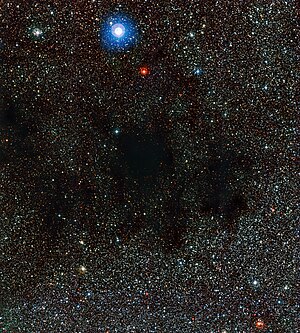Coalsack
| Dark nebula | |
|---|---|

The Coalsack Nebula taken by the Wide Field Imager on the MPG/ESO 2.2-metre telescope.
|
|
| Observation data: J2000.0 epoch | |
| Right ascension | 12h 50m |
| Declination | −62° 30′ |
| Distance | 600 ly |
| Apparent magnitude (V) | – |
| Apparent dimensions (V) | 7 × 5 ° |
| Constellation | Crux |
| Physical characteristics | |
| Radius | 30–35 ly ly |
| Absolute magnitude (V) | – |
| Notable features | – |
| Designations | C99 |
The Coalsack Dark Nebula (or simply the Coalsack) is the most prominent dark nebula in the skies, easily visible to the naked eye as a dark patch silhouetted against the southern Milky Way. It is located at a distance of approximately 600 light years away from Earth, in the constellation Crux.
The Coalsack Dark Nebula covers nearly 7° by 5° and overlaps somewhat into the neighbor constellations Centaurus and Musca. The first observation was reported by Vicente Yáñez Pinzón in 1499. It was named “il Canopo fosco” (the dark Canopus) by Amerigo Vespucci and was also called “Macula Magellani” (Magellan's Spot) or “Black Magellanic Cloud” in opposition to the Magellanic Clouds.
In 1970, Kalevi Mattila proved the Coalsack is not totally black. It has a very dim glow (10% of the brightness of the surrounding Milky Way), which comes from the reflection of the stars it obscures.
The Coalsack is not present in the New General Catalogue and in fact does not have an identification number (outside of the Caldwell Catalogue, in which it is C99).
The Coalsack is important in Australian Aboriginal astronomy, and forms the head of the Emu in the sky in several Aboriginal cultures. Amongst the Wardaman people, it is said to be the head and shoulders of a law-man watching the people to ensure they do not break traditional law. According to a legend reported by W.E. Harney, this being is called Utdjungon and only adherence to the tribal law by surviving tribe members could prevent him from destroying the world with a fiery star. There is also a reference by Gaiarbau (1880) regarding the coalsacks replicating bora rings on earth. These astronomical sites allowed the spirits to continue ceremony similar to their human counterparts on earth. As bora grounds are generally located on the compass points north/south, the southern coal sack indicates the initiation/ceremonial ring.
...
Wikipedia
